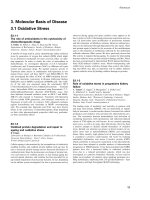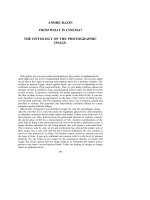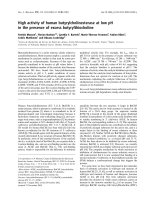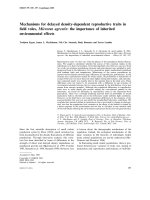Redefining Gender in Twenty-First Century Spanish Cinema: The Films of Pedro Almodóvar pptx
Bạn đang xem bản rút gọn của tài liệu. Xem và tải ngay bản đầy đủ của tài liệu tại đây (1.15 MB, 161 trang )
Glasgow Theses Service
/>
Wardrop, Georgina (2011) Redefining gender in twenty-first century
spanish cinema: the films of Pedro Almodóvar.
MPhil(R) thesis.
Copyright and moral rights for this thesis are retained by the author
A copy can be downloaded for personal non-commercial research or
study, without prior permission or charge
This thesis cannot be reproduced or quoted extensively from without first
obtaining permission in writing from the Author
The content must not be changed in any way or sold commercially in any
format or medium without the formal permission of the Author
When referring to this work, full bibliographic details including the
author, title, awarding institution and date of the thesis must be given
Redefining Gender in
Twenty-First Century
Spanish Cinema: The Films
of Pedro Almodóvar
University of Glasgow
Master of Philosophy
Georgina Wardrop MA (Hons)
0404864
Abstract: Redefining Gender in Twenty-First Century Spanish Cinema:
The Films of Pedro Almodóvar
The aim of this research is the evolving cultural conception of gendered identities in
prominent and significant films produced in 21
st
Century Spanish cinema of
filmmaker Pedro Almodóvar. This research project will examine how new images of
gender representations appear at the turn of the 21
st
Century in which the focus is
characterised by the tensions between subjective experience and the broader social
collectivity. A gender-based theoretical framework will be applied, using
psychoanalysis as a tool to deconstruct, analyse and gain in-depth insight into
strategies applied by Almodóvar in order to challenge patriarchal and repressive
stereotypes and practices throughout his 21st Century filmography. This analysis will
create a dialogue between psychoanalytic theory and the film narrative,
demonstrating how psychoanalytic notions have been portrayed through the
medium of film, defining male and female subjectivity in cinema and in wider
society. This thesis examines
upon which the representation and perceptions of gendered
identities can be regarded as having moved towards a sense of sophistication. Given
the increasing importance attached to cultural and gender studies, research into 21
st
Century Spanish cinema is still a new and largely unexplored area. This thesis
provides a distinctive contemporary insight into Spanish Cinema and gender politics.
The discourse constructed, deconstructed and reconstructed by Pedro Almodóvar
will be analysed in order to represent new conceptions of identity, sexuality and the
redefinition of gender in 21
st
Century Spanish Film.
Contents
Acknowledgements
Introduction 1
Chapter I From Object to Subject in Hable con Ella 17
Chapter II Crossed Identities and Performance in La Mala Educación 51
Chapter III Female Agency in the Midst of the Feminine Sphere in Volver 77
Chapter IV Redefining the Gaze in Los Abrazos Rotos 113
Conclusion 141
Bibliography 149
Acknowledgements
I wish to express my sincere gratitude to the following people for their help, support
and guidance in the completion of my MPhil by Research:
Dr Brígida Pastor, my thesis supervisor, for her continuous support, supervision and
enthusiasm in the development of my thesis. I would also like to thank Dr Pastor for
instilling the passion of Spanish Cinema into my life during my Honours years as an
Undergraduate student at the University of Glasgow. Her broad expertise in Spanish
Film and Gender Studies has proved invaluable to the development of my research
to date.
Staff at the Department of Hispanic Studies at the University of Glasgow for their
guidance and excellent standard of teaching throughout my years as a student within
the University department. Special mention must go to; Dr Karen Peña, Dr John
McCulloch, Miss Esther Tallada, Dr Paul Donnelly and Professor Mike González for
their lecturing, tutoring and guidance over the years.
On a personal note, my deepest thanks must go to my family and friends who have
supported me through my studies and given me the enthusiasm I needed when it
seemed like an uphill mountain to climb. I would also like to thank those closest in
my life for listening, advising and providing a constant source of understanding.
Redefining Gender in Twenty-First Century Spanish Cinema: The Films of Pedro
Almodóvar
1
Georgina Wardrop (0404864)
2011
Introduction
Redefining Gender in Twenty-First Century Spanish Cinema: The Films of Pedro
Almodóvar
2
Georgina Wardrop (0404864)
2011
Introduction – Redefining Gender in Twenty-First Century Spanish
Cinema: The Films of Pedro Almodóvar
The death of General Francisco Franco on the 20
th
November 1975 and the abolition
of censorship in Spanish Cinema shortly after on the 14
th
February 1976
1
, both
2
, enabling Spanish film
directors to freely and openly challenge the dominant patriarchal ideals and values
that were, and continue to be, present in classic dominant cinema.
These conventions and values in Spain inevitably stemmed from the patriarchal and
ideological regime of the right-wing dictatorship that encompassed Spanish society
for thirty-six years. It could be essentially argued that classic dominant cinema grew
istic
machine which other national and regional cinemas followed. The Hollywood
institution can be seen as the pioneering pinnacle of cinema as the medium of film
which has penetrated the world, reaching cinemas and households in every country
1
José Enrique Monterde, Veinte Años de Cine Español (1973-1992): Un Cine Bajo la Paradoja,
Barcelona: Edición Paidós, 1993, p.207
2
Marsha Kinder ar
p.27 many of the
foundations of reaction towards dominant conventions and values of the right wing dictatorship of
General Francisco Franco were established during this influential congress; ultimately, the rejection of
cin
vehicle of ideological reinscription, one that was opposed both to fascism and to Hollywood, which
were perceived as aligned partly because conventions from popular Hollywood genres had been so
Blood Cinema: The Reconstruction of National Identity in Spain, London: University of California Press,
1993, p.36
Redefining Gender in Twenty-First Century Spanish Cinema: The Films of Pedro
Almodóvar
3
Georgina Wardrop (0404864)
2011
thinkable, in every format possible; and in turn reflecting social changes and
arguably shaping cultural attitudes.
3
The argument crucial to the backbone of many
4
transporting
ideological perspectives to the minds of the spectators in the cinema hall. These
ideological perspectives hail from patriarchy, the male dominated discourse that can
be seen and reflected in film. E. Ann Kaplan eloquently furthers this idea by arguing
f
patriarchy; film narratives are organized by means of a male-based language and
5
cinema, would cont
rship, but also after his death, leading Spanish
film directors, such as Pedro Almodóvar, amongst others, to both directly and
indirectly challenge patriarchal and phallocentric discourse through the discourses of
the narratives produced.
Film can be considered as a reflection of social ideals, values and changes as such
the images portrayed in dominant (Hollywood) cinema can be seen as
representations of a largely male-dominated, patriarchal society
6
. Subsequently,
these patriarchal cultural representations in film can reflect the spectator and his or
3
Feminist Film Theory:
A Reader, Edinburgh: EUP, 1999, p.10
4
Thornham, 1999, p.12
5
Women and Film: Both Sides of the Camera, London: Methuen,
1983, p.30
6
Steven Marsh & Parvati Nair (eds.), Gender and Spanish Cinema, Oxford: Berg, 2004, p.1
Redefining Gender in Twenty-First Century Spanish Cinema: The Films of Pedro
Almodóvar
4
Georgina Wardrop (0404864)
2011
her personal ideologies. Steven Marsh and Parvati Nair acknowledge this by stating
provided a key means by which to refigure national identity or, indeed, to challenge
7
This study will therefore
8
film theory as a tool, intertwining filmic discourse and psychoanalytic theory in order
to deconstruct and decode phallocentric ideals, values and conventions that are
engrained in film narratives and in turn, arguably, engrained in society. The aim is
not only to examine these ideals and values, but to highlight Pedro
attempts at contesting the status quo as Marsh and Nair observe, and in turn
challenging these structures that have existed and continue to exist in Post-Francoist
cinema.
Pedro Almodóvar Caballero
9
can arguably be considered as the leading
contemporary Spanish filmmaker with an international reputation. Mark Allinson
10
. His timely entrance into the Spanish
previous Spanish filmmakers (such as Juan Antonio Bardem, Luis Buñuel, Carlos
7
Marsh & Nair 2004, p.3
8
expressed in the one of the points in feminism is
that it attempts to create a space where women can be speakers/agents as women. (See Margaret
Whitford, Luce Irigaray. Philosophy in the Feminine (London/New York: Routledge, 1991). p. 129.
9
Born in September 1951 in Calzada de Calatrava, Cuidad Real, Spain
10
Mark Allinson, A Spanish Labyrinth: The Films of Pedro Almodóvar, London: I.B Tauris, 2001, p.3
Redefining Gender in Twenty-First Century Spanish Cinema: The Films of Pedro
Almodóvar
5
Georgina Wardrop (0404864)
2011
Saura, amongst many others
11
) and their individual and collective attempts to both
directly and indirectly challenge the aforementioned patriarchal and phallocentric
discourse that has been present and continues to be present through the influences
of dominant Hollywood cinema. Almodóvar takes these challenges to a somewhat
higher level with the crippling constraints of Francoist right-wing censorship a thing
of the past after the abolition of such censorship in 1977.
12
It is not to be considered
a black and white binary shift from dictatorship to democracy, but rather a gradual
process that required not only political and constitutional reform,
13
but also a
cultural revolution in Spanish history, specifically through the medium of film
embracing and even surpassing the boundaries of what could be considered
eye of the spectator.
Due to his iconic status as the most successful Spanish filmmaker of the present day,
It would be almost impossible to draw a full critical review on the breadth and depth
of research available. However it is my aim to pay particular homage to writers who
have undoubtedly influenced and added greater scope to my research on
st
Century cinema. The crux of my research culminates in the idea
11
This study shall focus on Spanish Cinema of the 21
st
Century however, it is noted that Spanish film
today would not be where it sits in the cinematic field; were it not for the attempts of filmmakers of
the previous centuries (such as that of the 20
th
) attempts to destabilise the patriarchal norm of
dominant Hollywood cinema. Notable research that focuses on previous ages of Spanish film and
which I have found particularly useful throughout my research are; Peter W. Evans (ed.), Spanish
Cinema: The Auteurist Tradition, Oxford: Oxford University Press, 1999, Robert W. Fiddian & Peter W.
Evans, Challenges to Authority: Fiction and Film in Contemporary Spain, London: Tamesis Books, 1981
and Marsha Kinder, Blood Cinema: The Reconstruction of National Identity in Spain, California:
University of California Press, 1993
12
Evans, 1999, p.xix
13
Allinson, 2001, p.3
Redefining Gender in Twenty-First Century Spanish Cinema: The Films of Pedro
Almodóvar
6
Georgina Wardrop (0404864)
2011
that Almodóvar provides new spaces and a platform onto which marginal characters
or groups are enabled to have a voice that will in turn penetrate the wider society
that has been influenced by engrained beliefs, values and stereotypes that patriarchy
has prescribed over centuries. Allinson in his 2001 work titled A Spanish Labyrinth
14
,
opened my eyes on an introductory level to the historical background of
and performance. The breaking down of research into context, content and
construction has proved to be a valuable tool in understanding such issues and his
in-depth analysis of performance and sexuality has proved crucial in the
development of Chapter II, focusing on La Mala Educación (Bad Education).
In continuing with the theme of sexuality within the film narrative, it would not be
Smith. In Laws of Desire,
15
Smith undertakes an incisive analysis of the portrayals of
homosexuality in both Spanish writing and film. With a large part of this research
canon of Almodóvar criticism. He argues against the common perception that
Almodóvar makes a conscious effort to repress history in his work, putting forward
the case that this political and historical emphasis is instead embedded within the
filmic narrative, without being openly voiced in the dialogue.
16
It has been my
intenti
14
Allinson, 2001
15
Paul Julian Smith, Laws of Desire: Questions of Homosexuality in Spanish Writing and Film 1960-
1990, Oxford: Clarendon Press, 1992
16
Smith, 1992, p.171
Redefining Gender in Twenty-First Century Spanish Cinema: The Films of Pedro
Almodóvar
7
Georgina Wardrop (0404864)
2011
st
Century work. Just like the political and historical emphasis which is
not openly voiced in the dialogue according to Smith, it is my aim to portray the idea
that margiork is also not openly voiced, but is instead
embedded within the filmic narrative homosexual characters are
simply exist;
filmic texture of his complex narratives. These concepts in relation to sexuality that
Smith observes will be applied throughout this entire thesis, taking into account the
personal view that a challenging of authority in relation to a particular marginalised
group can in turn be applied to all marginalised groups collectively. The struggles
facing the issue of sexuality, for example, can also arguably be applied to gender.
to create a space for further marginal characters such as homosexual males, females,
drag queens and vice versa.
A key text that has influenced this research has been All About Almodóvar: A Passion
for Cinema
17
. Along with significant contributions from both editors to the volume,
this recent work brings together influential articles by Paul Julian Smith, Kathleen
Vernon, Isolina Ballesteros, Andy Williams, Linda Williams, Peter William Evans, Mark
concepts under sections named: Form and Figures, Melodrama and its
Discontents, The Limits of Representation and the Auteur in Context, many of
17
Brad Epps and Despina Kakoudaki (eds.), All About Almodóvar: A Passion for Cinema, Minneapolis,
MN, London: University of Minnesota Press, 2009
Redefining Gender in Twenty-First Century Spanish Cinema: The Films of Pedro
Almodóvar
8
Georgina Wardrop (0404864)
2011
the individual articles have undoubtedly added significant insight to the
development of this thesis which focuses on the representations and portrayals of
st
Century cinema.
Before embarking on the empirical part of my discussion, it may be helpful if I first
According to
Simone de Beauvoir in The Second Sex,
18
. This has been a landmark phrase which has been at the centre of the
gender/sex debate for many years. This debate comes down to the sociological
concepts of nature and nurture
19
. Does our biological sex determine our gender? Or
through socialisation processes?
as a process which is not determined by birth, suggests that gender is a social and
cultural construct. Gender is further problematised by concepts such as gender
neutrality or transgender which Almodóvar painstakingly integrates into his work
and will be examined in Chapters I and II. This is when the concept of gender identity
often comes into place as many people undertake the process of coming to terms
with their new self identity and also to how others perceive this identity in society.
Many refuse to accept that their gender falls into the black and white, binary
dichotomy of male and female; a dichotomy arguably created by patriarchy to suit its
values and ideals of what a male and female should be. I will argue that Almodóvar
18
Simone de Beauvoir, The Second Sex, H.M Parshley, London: Vintage, 1997, p.295 (Original: Simone
de Beauvoir, Le Deuxieme Sexe, Paris: Gallimard, 1949, vol.2, p.13)
19
David C. Rowe, The Limits of Family Influence: Genes, Experience, and Behaviour, New York: Guilford
Press, 1994, pp.2-3
Redefining Gender in Twenty-First Century Spanish Cinema: The Films of Pedro
Almodóvar
9
Georgina Wardrop (0404864)
2011
challenges this binary dichotomy, by introducing through his filmic narratives a grey
area which does not correspond to the black and white binary that patriarchy has
stereotypically prescribed.
Like Almodóvar, Judith Butler, an US Philosopher and third-wave feminist argues that
feminism seems to have made a great error in defining women as one entity,
therefore reinforcing this binary, black and white view of gender and gender
relations
20
. She eloquently argues that instead, gender should be seen as fluid,
something which can change depending on the time and the context. Butler
21
; she
puts forward the argument that we all put on a gender performance, regardless of
whether this performance fits into the binary view of what is socially and culturally
Butler calls for an active approach to changing these views and gender norms by
in order to move feminism from the
approach taken by many that women all share common characteristics and interests.
It can be argued that Almodóvar has taken this active approach that Butler calls for
in order to challenge and change these views and gender norms. By creating gender
Butler, like Almodóvar, believes that this will eventually lead to the change of these
20
Judith Butler, Gender Trouble: Feminism and the Subversion of Identity, London: Routledge, 1990,
pp.171-190
21
Butler, 1990, p.173
Redefining Gender in Twenty-First Century Spanish Cinema: The Films of Pedro
Almodóvar
10
Georgina Wardrop (0404864)
2011
and masculinity.
In order to examine and attempt to transform these existing engrained phallocentric
and archaic stereotypes and practices in the film narrative, it is important to consider
ways that aid the process of deconstruction and understanding of these engrained
conventions and stereotypes. Psychoanalysis can be used as a tool to deconstruct
and in turn understand these stereotypes and practices which can be considered to
have taken form in society as the absolute truth
22
. It is understandable that after
years of patriarchal ideology that was engrained in Spanish society, and due to the
binary black and white gender norms that condemned the female to a subordinate
role in society
23
, that it was difficult to accept the female as an intelligent and more
importantly active agent in film. It is this role as active agent that Almodóvar strives
to portray through his female characters in his filmography; his ultimate purpose is
to break the stereotypical barriers that marginal characters face as reflected in both
film and society. It is furthermore noted that patriarchal structures stereotypically
confine characters to particular roles and spaces. Psychoanalysis therefore allows for
the unlocking of secrets and reasons as to why both female and male characters
have been restricted to these confined spaces throughout the course of the film
narrative.
22
Kaplan, 1983, p.34
23
, Laura Mulvey, Visual Pleasure and Narrative Cinema, Feminism and Film, Oxford: OUP, 2000,
pp.39-40
Redefining Gender in Twenty-First Century Spanish Cinema: The Films of Pedro
Almodóvar
11
Georgina Wardrop (0404864)
2011
In order to highlight the contestations and challenges of the status quo, I will adhere
to the pioneering psychoanalytical theories such as the male gaze
24
by Laura Mulvey
who patriarchal culture as signifier for the male
other, bound by a symbolic order in which man can live out his fantasies and
obsessions through linguistic command, by imposing them on the silent image of
woman still tied to her place as bearer of meaning, n
25
It is
through the male gaze
26
of the male protagonist, male director and male spectator
that Mulvey suggests, and
Almodóvar in his work, as specifically studied in Chapter I, portrays can be analysed
and deconstructed through concepts linked to the male gaze, including that of
fetishism
27
. E. Ann Kaplan draws on the Freudian theory of castration
28
, eloquently
arguing that fragmentation
29
of the female image can be seen as a form of fetishism;
it is in the act of what can be considered overt fragmentation of the female body
portraying the female as no longer a whole entity and instead compartmentalised
30
that the phallic image is often found; reducing the threat of the female with her lack
of the phallus and in turn, making her desirable to aforementioned male gaze. The
24
According to Mulvey, there are three gazes: that of the camera, the spectator and the male
protagonist in the diegesis. Mulvey argues that in dominant cinema each of these gazes are
considered male, fetishising and fragmenting the female form, rendering it devalued. 2000, pp.39-40
25
Mulvey, 2000, p.35
26
Mulvey, 2000, pp.39-40
27
Kaplan argues that the camera (unconsciously) fetishizes the female form, rendering it phallus-like
She continues her argument by
Men, that is, turn the represented figure itself into a fetish so that it becomes reassuring rather than
Kaplan, 1983, p.31
28
Sigmund Freud. The Standard Edition of the Complete Psychological Works of Sigmund Freud. Trans.
James Strachey. 24 vols. London: Hogarth, 1953-74.
29
Kaplan, 1983, p.31
30
Kaplan, 1983, p.31
Redefining Gender in Twenty-First Century Spanish Cinema: The Films of Pedro
Almodóvar
12
Georgina Wardrop (0404864)
2011
concepts of fragmentation and fetishism will be studied in depth throughout the
body of this research. Furthermore, these concepts have been researched, adapted
and further explored by further feminist film theorists such as Claire Johnstone,
Mary Ann Doane and Annette Kuhn. I ai
to such psychoanalytical theories, and I will draw particularly on several theoretical
concepts introduced by Laura Mulvey and E. Ann Kaplan. Of all the theorists I have
considered throughout this research, Mulvey and Kaplan have been especially useful
because of their interest in the image of gender as portrayed through film: Mulvey
influential essay titled Visual Pleasure and Narrative Cinema
31
encapsulates the
main basis of this stud eloquent argument, which mirr
32
, sets in process the
psychoanalytic tool that enables film critics to examine phallocentric discourse and
images throughout the filmic text.
This coded discourse is covertly placed by Almodóvar as an attempt to indirectly, or
-thought
based consideration of the concept of the active male and passive female
33
, which is
34
females in a comatose state
in Hable con Ella, can also be stated as present within each of the four Almodovarian
31
Mulvey, 2000
32
Mulvey, 2000, p.39
33
Mulvey, 2000, p.39
34
See Chapter I (pp. 17-50) for in depth analysis on the active male and passive female in relation to
Hable con Ella
Redefining Gender in Twenty-First Century Spanish Cinema: The Films of Pedro
Almodóvar
13
Georgina Wardrop (0404864)
2011
films this thesis will examine. Her theory will prove to be a crucial tool throughout
selected films.
35
Visual Pleasure and Narrative Cinemaing Freudian theory and
36
theory can in fact be
challenged. Kaplan, like Almodóvar, in Chapter III and IV in Volver and Los Abrazos
Rotos, questions whether women can take the dominant, active position, or whether
by attempting to take this position which has not been prescribed to them by
37
. She, like Almodóvar, eloquently
-existing patterns of fascination already at work within the individual
,
38
acknowledging the idea
that phallocentric discourse is evidently present in dominant cinema and using
39
My examination of , using psychoanalytic theory as a
crucial tool to uncover myths and secrets pertaining to patriarchal society and
subsequently reflected in film, is certainly not the first to draw on such theories: but
through in-depth deconstruction of in order to explore the
evolving portrayals of gender in his 21
st
Century filmography, I believe my analysis
35
Kaplan, 1983
36
Hable
con Ella (2002), Mulvey, 2000, p.39
37
Kaplan, 1983, p.29
38
Kaplan, 1983, p.34
39
aplan,
1983, p.34
Redefining Gender in Twenty-First Century Spanish Cinema: The Films of Pedro
Almodóvar
14
Georgina Wardrop (0404864)
2011
will offer a novel view of Almodóvar as a pioneer of the redefinition of gender.
Moreover, my study can arguably be considered the first which attempts to trace the
and alternative
sexualities in the 21
st
Century.
This analysis will create a dialogue between psychoanalytic theory and filmic text. I
will show how psychoanalytic notions have been portrayed through the medium of
film; in turn defining male and female subjectivity in cinema and in modern society.
The hypothesis formed in the initial selection of films of the 21
st
Century
Almodovarian filmography
work is constantly forming, reforming and transforming itself; his years of experience
and his first feature film post-Franco Pepi, Luci, Bom y otras chicas del montón (Pepi,
Luci, Bom and Other Girls on the Heap) in 1980, can be seen to have influenced the
transition
and Peter Evans have observed the pieces of
its lost identity,
40
It is
this observation that I aim to take forward to a different level; that instead of being
anchored in the past, Almodóvar has taken agency in the creation of a new future for
Spanish film, surpassing the boundaries and stereotypical confines in relation to
gender that patriarchy has prescribed to the Spanish nation over years of a right-
wing dictatorship. It is by choosing
40
Fiddian & Evans, 1981, p.7
Redefining Gender in Twenty-First Century Spanish Cinema: The Films of Pedro
Almodóvar
15
Georgina Wardrop (0404864)
2011
both the feminine and masculine sphere in his characterisation of the film narratives
examined. I believe
earlier representations of invisibility, complexly yet indeed crucially reversing the
centuries-old legacies of sexual discrimination in film and in society. It is for this
reason that Chapter I will closely analyse the film Hable Con Ella (2002), arguing the
shift from subject to object, from active to passive in the characterisation of the
male and female characters in the narrative. Chapter II will focus on La Mala
Educación, 2004, analysing crossed identities and performance within the film
narrative and discourse. Chapter III will shift focus from the arguably more male-
driven narratives previously analysed to a more feminine narrative in Volver, 2006,
magnified feminine world results in new spaces and opportunities for women and
marginalised groups as a whole. The f
present film to date, Los Abrazos Rotos, 2009, in which Almodóvar presents an overt
redefinition of the gaze through a blind male protagonist who would arguably, in
classic dominant cinema, usually take form as the vehicle
gaze
41
would tend to make itself apparent through the discourse of the narrative.
This study will offer a novel examination of the redefinition of the concept of gender
reflected and portrayed through the medium of film. Al
redefinition and subsequent refiguring of concepts, stereotypes, ideals and values
41
Mulvey, 2000, pp.39-40
Redefining Gender in Twenty-First Century Spanish Cinema: The Films of Pedro
Almodóvar
16
Georgina Wardrop (0404864)
2011
pertaining to traditional norms will arguably culminate in the cre
Redefining Gender in Twenty-First Century Spanish Cinema: The Films of Pedro
Almodóvar
17
Georgina Wardrop (0404864)
2011
Chapter I
From Object to Subject in
Hable Con Ella
Redefining Gender in Twenty-First Century Spanish Cinema: The Films of Pedro
Almodóvar
18
Georgina Wardrop (0404864)
2011
Chapter I - From Object to Subject in Hable con Ella
-length feature film Pepi,
Luci, Bom y otras chicas del montón (Pepi, Luci, Bom and Other Girls on the Heap),
1980, and thirteen subsequent feature films
42
, the 21
st
Century has signalled a new
phase of filmmaking for Almodóvar, bringing issues of gender to the forefront and
tackling engrained cinematic and social inflections of patriarchal society, the
dominant society that significantly influences everyday life. While the coming
chapters will discuss these issues in greater depth, our present concern is with
Hable con Ella (Talk to Her), a film which can be seen to
the predominance of female
characters in his narratives
43
. Here, he uses the female as the means to foreground
the male story, thus supporting the argument within this thesis as a whole that
Pedro Almodóvar is in fact an advocate for the marginal strands of society, especially
in relation to gender, identity and sexuality.
Hable con Ella (Talk to Her) 2002, tells the story of Benigno Martín and Marco
Zuluaga, two men who once cross paths at a ballet performance to be united later
42
For a comprehensive filmography and plot summary of Pedro Almod
Mark Allinson, A Spanish Labyrinth: The films of Pedro Almodóvar, London: I.B Tauris, 2001, pp 230-
244
43
Allinson, 2001, p.72
Redefining Gender in Twenty-First Century Spanish Cinema: The Films of Pedro
Almodóvar
19
Georgina Wardrop (0404864)
2011
within the confines of a hospital ward where Benigno works as a nurse caring full-
time for Alicia, a ballet student who lies unconscious in a coma after an accident. At
the clinic, Benigno is re-united with Marco who he noticed crying at the ballet
performance; however, this time they are re-
González, a famous Spanish female bullfighter, also lies in a coma after being gored
by a bull in the ring. As the narrative unfolds and the men watch over their comatose
love objects, their relationships with both Alicia and Lydia and somewhat
suggestively their relationship with each other are told through a narration of
flashbacks darting backwards and forwards in time. Events take a turn for the worse
as Benigno is imprisoned after raping Alicia while in a coma, as he believes both of
them to be deeply in love and declares his wish to marry her. In a desperate bid to
re-unite himself with Alicia, not bearing to be apart from her, he takes, as he thinks,
enough pills to send him into a coma, but instead overdoses and subsequently dies.
In a somewhat ironic twist to the tale, Alicia wakes up from her coma during
childbirth, giving birth to a stillborn baby, but Marco unfortunately does not reach
Benigno in time to tell him the news. Throughout this tale of love, loss, emotions,
and friendship, the story of both male characters is pushed to the forefront of the
agenda as Almodóvar emphasises the role of gender as a vehicle for subverting
existing norms and stereotypes that have held sway for centuries.
From the outset of the film narrative, Almodóvar instantly provides the audience
with the first instance of the conflict of binary gender identities and performance of
Redefining Gender in Twenty-First Century Spanish Cinema: The Films of Pedro
Almodóvar
20
Georgina Wardrop (0404864)
2011
gender
44
gradually pulls up in theatrical fashion to reveal the first ballet scene, Café Müller, by
Pina Bausch. The ballet consists of two women in white nightdresses, carelessly
stumbling around the stage where numerous obstacles (tables and chairs) are placed
into which the women collide. A male figure is seen in the darkness moving the
obstacles out of the way as the performance ends with the dancers falling to the
ground, almost as if ill and abandoning themselves to their fate. Mark Allinson,
Café Müller by Pina Bausch, presents a dystopian
world of illness and obstacles
45
, as Allinson
suggests, can be equated to the plot of the story to come as the two female dancers
perform, portraying a characterisation of insanity, with no control, their eyes closed,
in silence
blindly and in isolation through a forest of tables and chairs across a bare stage, are
metaphorical representations of the two comatose women in the main plot of the
46
44
Butler argues that feminism in its definition of gender as two black and white dichotomised entities
be considered a gender performance. This performance is performed regardless of whether it fits into
the binaries of wha Judith Butler, Gender Trouble:
Feminism and the Subversion of Identity, Routledge: London, 1990, pp.171-90. This theory will be
further developed in Chapter Two.
45
Brad Epps and
Despina Kakoudaki (eds.), All About Almodóvar: A Passion for Cinema, Minneapolis, MN, London:
University of Minnesota Press, 2009, p.152
46
Allinson, 2009, pp.152-153









